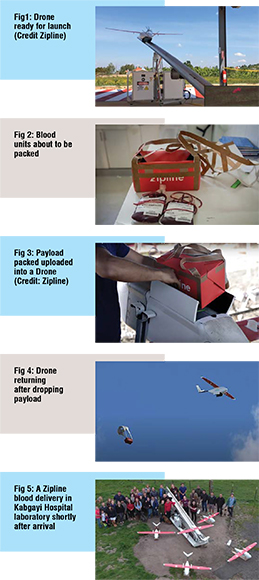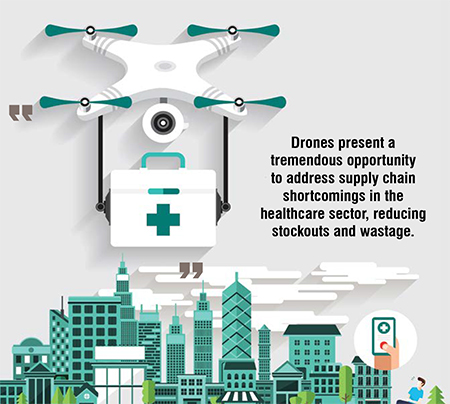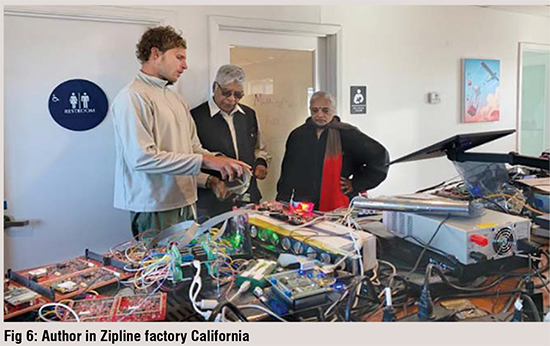A major concern in Telehealth was that while the healthcare provider could appear on a screen and make a reasonable diagnosis in truly remote areas making available drugs or vaccines or collecting biological samples for investigations was a major constraint. Today DRONES are increasingly being used in healthcare to reach the unreached and make isolation, relative not absolute. The very word INACCESSIBLE will slowly loose its meaning. This article reviews the process of deploying drones in healthcare. The author is optimistic that proof of concept studies will soon be carried out in rural India.
A healthcare provider can today, virtually appear on a screen, and most often make a reasonable diagnosis, and give proper advice reviewing available investigations. Distance has become meaningless. In fact, Geography has become History! However, in truly remote areas making available drugs, vaccines, blood or even collecting biological samples for investigations is a major constraint. Today drones are increasingly being used in healthcare to reach the unreached and make isolation relative, not absolute. The very word ‘inaccessible’ will slowly loose its meaning. This overview introduces the reader to yet another illustration of potential creative disruption in healthcare. The author is confident that we will see this happen in parts of rural India soon.
We are living in a time of technological revolution. However, it is well known that healthcare providers worldwide are ultra conservative. In a recent report, Goldman Sachs estimates the total global spending on drones over the next five years to be around US$100 billion. Drones have been used extensively by the military in combat. Most drone applications involve surveillance using an on board camera. Agriculture surveillance, crop spraying, shark surveillance at beaches, monitoring wildlife for conservation, monitoring fires, , monitoring riots and international borders by police and governments, sports, entertainment, event coverage, media coverage, emergency services disaster responses for humanitarian aid and scientific research and exploration are the various use cases. Amazon Prime Air is pioneering drone delivery of goods as heavy as five pounds to locations up to 30 minutes away. Today pizzas are being delivered through drones.
Drones are commonly known as Unmanned Aerial Vehicles (UAVs). This term was first coined in the 1980s to describe autonomous, or remotely controlled, multi-use aerial vehicles. Speed and versatility of UAV technology offers virtually unlimited opportunities to deliver needed medical supplies and assistance to individuals in remote or dangerous areas. They can even connect doctors to patients in a more expeditious manner. Victims of natural disasters or emergency situations could be administered life-saving care by good- Samaritan bystanders who are provided remote instruction on treatment administration.
Inclement weather conditions or differences in ambient temperatures may cause drones to lose their functionality. Cost of building and maintaining drones needs to be carefully reviewed so that a cost–benefit analysis could be done. Regulatory, legal and environmental issues need to be addressed
The more familiar public term “drone” was first coined because of the resemblance of the loud and cadenced sound of old military unmanned target aircraft to that of a male bee. In 1942, the Navy developed a radio-controlled drone that carried a torpedo. Today the drone is all set to be a major disruptive force in transportation. The origins of UAVs can be traced back almost 100 years dating back to World War I. While UAVs were originally created for the military, they are now being used for a wide variety of applications. A few weeks ago, the US military force used a drone controlled from the USA to selectively eliminate an Iranian General in Baghdad.
Every service provider wanting to deploy drones needs to overcome challenges ranging from payload capacity, safety, battery life and of course, regulations. Flight paths need to be provided and drones managed to ensure that the right package is transported in right conditions at the right emperature to the right location.
Aviation authorities need to work closely with Healthcare regulators before introducing specific regulations focusing on use of drones in the healthcare sector. Existing FAA (Federal Aviation Authority) guidelines state that drones must always be in the line of sight of the pilot. In addition, drones cannot exceed an altitude of 400 feet and cannot go faster than 100 miles per hour. Community outreach and engagement, oversight, audits, enforcements, security services coordination, cross-ministerial councils, unmanned traffic management Key Performance Indicators and public and private data transparency need to be taken into account. There is an increasing opportunity for countries to benefit from advanced drone operations, as associated technologies rapidly improve and evolve. Providing a planned revision of the policy or a continuous process for evaluating and re-evaluating the implementation policies for drone technologies according to KPIs is a new approach in governance. Sustainable integration of drones into health systems needs in-country capacities, markets and businesses to locally own and operate a drone-supported system.
Political awareness and desire to work with drones is increasing. Positive feedback from communities on the potential use of drones for health will ensure that political interests are aligned with drone project objectives. Commercial drone use is often held back by regulations (or the lack of it). Drones are often considered as aircrafts and pilots must adhere to strict line-of-sight rules, caps on altitude, and other restrictions. The recently released FAA new rules will hopefully regularise commercial operations.
Potential applications of UAVs in healthcare are broad based. They include (1) Prehospital Emergency Care, (2) Expediting Laboratory Diagnostic Testing and (3) Surveillance. Currently, UAVs have been shown to deliver vaccines, haematological products and automated external defibrillators. In addition, they are being used in the identification of mosquito habitats and drowning victims at beaches as a public health surveillance modality.

Currently in most centres in Africa it takes about 11 days to transport babies’ dried blood samples from a healthcare facility to a lab for HIV testing. It takes up to eight weeks to get the results. UNICEF led a project to try to speed up HIV testing of infants using helicopterstyle drones designed, built and programmed by Matternet.
In Rwanda, Zipline is able to maintain a ‘cold chain’ by delivering blood and pharmaceuticals to remote locations in hours. When the drones reach hospitals, they drop small packages from very low altitudes. The supplies are dropped using simple paper parachutes. The drones return to a home base. They are prepared for the next mission by putting in a new battery and a new flight plan stored in a SIM card. Zipline has flown more than 300,000 km in Rwanda delivering 7000 units of blood in over 4000 flights. Not a single unit of blood has been wasted.
Unmanned vehicles successfully delivered small aid packages after the Haitian earthquake in 2012, helped in humanitarian operations for collecting data and imagery where infrastructure was destroyed or already lacking, as in the Philippines after a typhoon in 2013. In 2017, Tanzania, announced its plans to adapt the Zipline drone delivery system to improve access to essential medicines as well as basic surgical supplies. Up to 2,000 deliveries per day are planned to fly to more than 1,000 health facilities and 10 million people across the country. In Malawi, in 2016, UNICEF and Matternet piloted the use of drones to fasten HIV testing procedures.
Drones have been used in Taiwan, Nepal, and other countries to reach remote villages and hospitals. Zipline will bring its drone delivery program to rural communities in Maryland, Nevada, and Washington, including some Native American reservations. Drones have delivered condoms and birth control aids to women throughout Ghana. In 2014, Médecins Sans Frontières demonstrated the use of drones for transporting sputum samples for tuberculosis diagnosis in Papua New Guinea. Drones provide fast, costeffective access to important diagnostic laboratory tests
The National Disaster Management Authority (NDMA) has started using drones to handle disaster relief and rescue in India. Similarly, during elections in the State of Chhattisgarh, the Central Reserve Police Force used UAVs for patrolling an area of 40,000 square kilometres and providing roundthe-clock surveillance. The Government of Uttar Pradesh has used drones for maintaining law and order at the Kumbh Mela festival in Allahabad, and so have the Mumbai police during the grandiose Ganpati festival. The National Thermal Power Corporation is using drones for predictive maintenance, and surveillance and intrusion detection in solar power plants. A UAV successfully transported a single unit of blood from a remote primary health centre in Uttarakhand’s Tehri district.
Drones could be a gamechanger in states that are particularly geographically difficult to traverse. A pilot project is expected to commence in Pune and Nandurbar. The launch will be supported through a grant from the Serum Institute of India, the largest vaccine manufacturer in the world. The government of Telangana in collaboration with Apollo Hospitals and the World Economic Forum has formalised the plan for a six-month pilot called ‘Medicines from the Sky’, starting in 2020. The project aims to explore the use of drones to increase access to healthcare for communities across the Telangana state.

Draft guidelines were originally issued in April 2016 by the Director General Civil Aviation Authority (DGCA). UAVs were categorised by weight into four classes: micro can go up to 2 kilos; mini between 2 to 20 kilos, small 21-150 kilos, and large exceeding 150. UAVs require a Unique Identification Number (UIN) issued by the DGCA. Moreover, all civilian UAV operations at or above 200 feet in uncontrolled airspace for any purpose require an unmanned aircraft operator permit (UAOP) from DGCA, while operation of civilian UAVs in controlled airspace is restricted. Drones are used for surveillance of disaster sites and areas with biological hazards, as well as in epidemiology for research and tracking disease spread.
In December 2018, India’s Ministry of Civil Aviation released a comprehensive framework for the operation of unmanned aerial systems (UAS), also known as drones. This would permit the use of drones for commercial purposes within Visual Line of Sight (VLOS). Flying a drone would require manual controls and an operator permit for licensed operations. Further, technical guidelines were released for policy-compliant manufacturing. In February 2019, the Drone Ecosystem Policy Roadmap was issued by the Ministry of Civil Aviation proposing carriage of new forms of airfreight, recognition of services providers for airspace deconfliction and permission (Digital Sky) and the ability to fly drones Beyond Visual Line of Sight (BVLOS). These policy evolutions are needed to implement drone delivery solutions for medical and other applications, as BVLOS flight is required to make drone delivery economically justifiable. Under the current regulations, drone delivery is not possible, although companies may file for an exception with the DGCA.
Through the development of microminiaturisation and widespread production of underlying technology, including processors, micro electrical mechanical systems (MEMS) sensors, and batteries produced for smart devices, drone designs have become more capable, affordable, and accessible. The common configurations include fixed-wing, rotary-wing, multi-rotor, and hybrid designs. infrared, multispectral and hyperspectral cameras. Drones typically consist of an airframe, propulsion system and navigation system.
Advancements in fields such as automation, robotics, miniaturisation, materials science, spectral and thermal imaging, and light detection and ranging have resulted in droneenabled solutions in areas as diverse as the agriculture, power, infrastructure, and telecom sectors, as well as crowd and disaster management. A dazzling variety of technologies—Wi-Fi communications, rechargeable batteries, small high-resolution digital cameras, GPS receiver chips, accelerometer chips, and other miniaturised electronics will make drones even more versatile
Fig 6 Author in Zipline factory California
Zipline drones – also called Zips – are specifically designed for their task. Compared to quadcopters, for example (another type of drone, with four rotors and four arms ending in propellers), battery-powered Zips are more efficient on long distances: They can deliver reliably to any site within an 80-kilometer radius on a pre-programmed route and with real-time monitoring. A quadcopter can reach only a radius of approximately five to ten kilometers. Accelerating from zero to over 100 kilometers per hour in half a second, Zipline drones deliver essential medical products of up to 1.8 kilograms per flight. Each Zip is sending its position every couple of seconds on the trip to and from the hospital. This way, the team can permanently track the drone and ensure a safe delivery. Healthcare providers order blood via text message. When received, operators prepare the blood payload and launch the aircraft. Zip drones have a flight range of 75 miles and can carry 3 pounds of blood. At the point of need, the blood payload is dropped via parachute to the waiting medical providers. Delivery time has been reduced from 4 hours to just 30 minutes. New drones now have a range of 99 miles carrying up to 3.85 pounds. The unmanned planes are navigated using cellular networks and GPS, and can make deliveries within 30 minutes.
It has been suggested that Drones can even be used to move medicines from floor to floor. The steady rhythm of packing, launching, collecting and charging the drones belies the groundbreaking technological advances in robotics, autonomous navigation and aerospace management that underpin the business.

A recent Johns Hopkins study found that using drones resulted in a logistics cost savings of up to US$0.21 per dose of vaccine when compared to traditional delivery. Drones increased vaccine availability and decrease costs over a wide range of settings provided they are used frequently to overcome initial capital costs of installation and maintenance. For drones to be effective, the effects of flight must not alter medical supplies. Several studies have confirmed that there are no changes in temperature, pressure and forces of gravity.
The response time of the drones depend on the speed, altitude, and acceleration of the drones, as well as their capacity to carry an AED and safely release it to a bystander. Dispatch to arrival time with drones was 5.21 minutes, whereas by ambulance it was 22 minutes. A drone could be summoned with a smart phone app. Bystanders would be instructed through the drone on how to perform CPR and start using the automatic defibrillator until the emergency services arrive to take over.
By moving certain expensive functions off-site — such as food service, pharmaceuticals and inventory management — and instead delivering those goods on-demand by drone, hospitals could save funds. Drones could deliver medications and supplies to patients being cared for in the home instead of a hospital-based setting. Blood samples collected at home could be delivered to the lab through a drone.
Conclusion
Drones are increasingly being tested for healthcare purposes around the globe. It is a tool complementary to existing transport systems offering advantages over traditional approaches in specific circumstances. How and where drones optimally fit into health systems is still being determined and will depend on local needs and resources. Currently, projects attempting bi-directional drone transport are still exploring possibilities, advancing the technologies and gathering real-world experiences. The integration and optimisation of new technologies into health systems takes years. As with any innovative health intervention, the sustainability of drone-supported Healthcare systems will depend on strong capacity building, an efficient impact monitoring and evaluation cycle and in-country commitment, including investment in drone regulations, project design and long-term ownership. Drone use offers the opportunity of improving healthcare, particularly in remote and/or underserved environments by decreasing lab testing turnaround times, enabling just-in-time lifesaving medical supply/device delivery, and reducing costs of routine prescription care in rural areas.
The World Economic Forum’s Medicine from the Sky project aims to answer one important question: How can we accelerate the transformation from analogue and inefficient health supply chains to digital, resilient infrastructure that reduces wastage and improves health outcomes? At its core, this project focuses on multi-stakeholder engagement that drives meaningful conversations about methodology, explores challenges to current systems and unlocks opportunities for collaboration leadership between the public and private sectors alongside civil society.
Drones present a tremendous opportunity to address supply chain shortcomings in the healthcare sector, reducing stockouts and wastage. Deaths due to diseases such as dengue, conditions like postpartum haemorrhage, loss of blood due to accidents and even time critical organ grafting can be addressed through faster responses, higher-quality products and better availability. Health system shortcomings, especially those felt in rural communities suffering from a lack of infrastructure and forecasted growth that outpaces investment, can be addressed and lives saved by adopting advanced logistics systems in the sky.
We should, however, always remember that technology is not an end in itself but only a means to achieve an end. All disruptive technology also have limitations and disadvantages. These need to be factored in also.